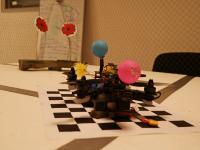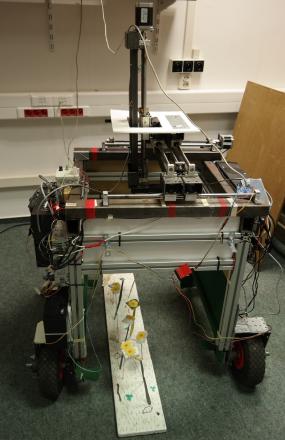B-Droid – a robot that's busy as a bee
Researchers from the Warsaw University of Technology have been working on an automated pollination system for 4 years now. First a mobile version with wheels, and now the flying B-Droid has been garnering considerable interest not only in Poland. That's hardly surprising, as our scientists have developed software for devices that can effectively help bees in their core, from our point of view, activity – pollination.
For a number of years, there have been mass deaths of bees worldwide. Environmental pollution, fungi, viruses or parasites might be to blame. Also, bees don't travel long distances well. In the United States they are transported hundreds of kilometres and, after several days of pollination, they die of fatigue. The effects of such a situation may be direr than we all think. It's estimated that a third of all agricultural crops and approximately 90% of plants growing in the wild require pollination, and bees are the main pollinators. Scientists from the Warsaw University of Technology have decided to rise to the challenge and build a robot for pollinating.
The team is led by Rafał Dalewski Ph.D. (Eng) from the Faculty of Power and Aeronautical Engineering. B-Droid has been designed under the “Autonomous device for mechanical plant pollination” [Autonomiczny układ do mechanicznego zapylania roślin] project financed by the LIDER programme. The scientists received over PLN 1 million in financial support for their research.
In 4 years they managed to create an autonomous system for mechanical plant pollination. Two versions of the solution were tested: one with wheels and one flying. Scientists from many different disciplines worked on B-Droid: programming, aerodynamics, mechanics, material strength, robotics, automation, electronics, with several people working simultaneously at the most intense time.
Bee on wheels
The first version of the device is a robot on wheels that carries a computer with the necessary software. This allows it to perform its tasks completely autonomously. “We set a target, press 'start' and it goes to work”, Dalewski explains. “The robot observes the terrain using cameras and checks the captured images for the presence of flowers in the vicinity.”
Furthermore, by analysing images from the cameras it can create a map of the terrain and determine its own location. Then, if the robot “sees” a flower, it establishes its location and prepares data needed to reach the flower with a brush for moving pollen, collect the pollen and move it to the next flower that's detected.
Of course, the user can see what's happening with the robot, but B-Droid performs its entire mission autonomously.
Pollinating drone
The flying B-Droid is simply a quadcopter, whose computer (software) remains on the ground. All operations are supervised by an external computer, but the on-board electronics allow analysis and data transfer, among other things. The images from the cameras are used by the computer to plan its route to the flowers. Once it determines their location, as well as its own, a flight path is plotted.
However, the flying device is much more challenging in terms of navigation and consumes more energy at the same time. The on-board battery allows only a couple minutes of flight, while the rolling version of the B-Droid manages over 2 hours.
The proof is in the pollen
People often say that somebody is as busy as a bee. Can the B-Droid match it? As it turns out –yes!
In the summer of 2016, the scientists confirmed that their wheeled robot can successfully pollinate garlic and strawberries. The rows of garlic plants, where the device worked, yielded approx. 165 seeds. In comparison, the area not used for testing gave 23 seeds. The seeds formed thanks to B-Droid's pollinating activities were also 6% heavier, which means higher quality.
Work on the flying system finished in September 2016, so the researchers haven't had a chance to perform field testing yet.
When can artificial bees help the real ones?
As work progressed on the project, it transpired that some ideas had to be abandoned. “We were working on our own aerodynamic solution, but we had to discard it, as we wouldn't be able to develop everything at the same time”, Dalewski explains.
The devices that can be seen at the Faculty of Power and Aeronautical Engineering are demonstration units for some solutions. After all, it would be impossible to test the software without putting it to work.
Dalewski plans to bring the product to market within approximately 2 years. “With the commercialisation I want to focus on the ground-based device first and foremost, as it simply has better market potential”, the researcher explains. “First of all, using wheels is more energy efficient, with a small gel battery allowing the robot to work more than two hours in the field and even all day with an additional generator.”
The device designed at the Warsaw University of Technology is part of precision agriculture, a trend that has been in development for several years, mainly in the USA, but also in Europe. Precision agriculture leads to the creation of devices that allow intelligent distribution of plant protection products and fertilisers. Optimisation of processes allows a significant reduction in spending on plant protection products and enables precise application of fertilisers. In the next phase of B-Droid development it will be possible to support these processes.
Bee deaths are a global phenomenon that threatens all of the civilisation: if no action is taken to help save them from mass extinction, the whole world will face a huge crisis. Therefore, we must do everything to at least maintain the current population size. B-Droid doesn't solve the root cause of the problem but can help natural pollinators in their work and lead to an increase in the efficiency of agriculture in our expanding and increasingly hungry world.
Monika Bukowska
Office for Promotion and Information









